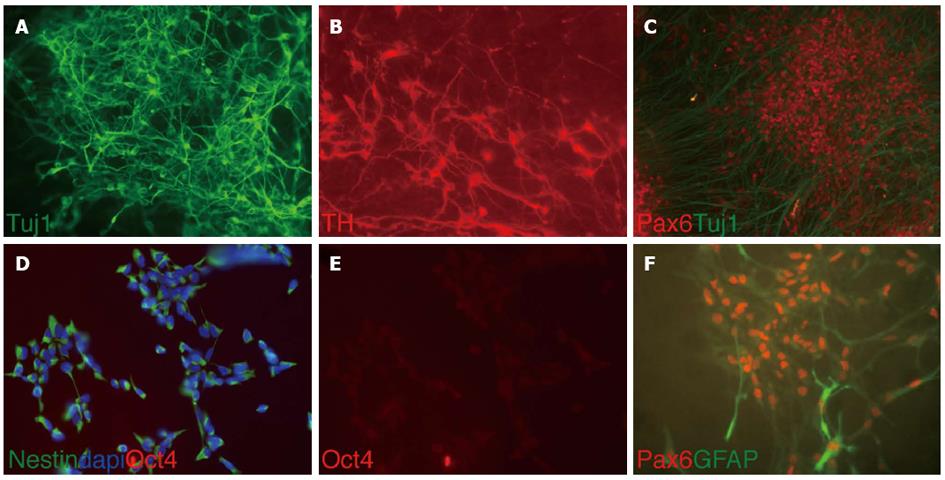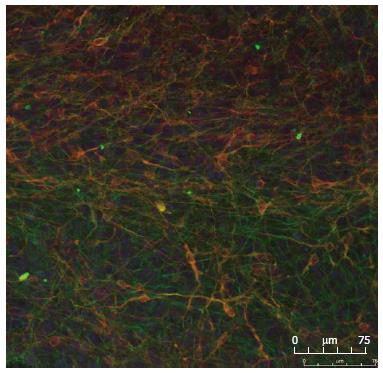Copyright
©2014 Baishideng Publishing Group Co.
World J Stem Cells. Apr 26, 2014; 6(2): 248-255
Published online Apr 26, 2014. doi: 10.4252/wjsc.v6.i2.248
Published online Apr 26, 2014. doi: 10.4252/wjsc.v6.i2.248
Figure 1 Immunofluorescence staining of human neural progenitor cells for stem cell markers.
A: Human neural progenitor cells express the stem cell marker nestin (green, dapi: blue); B: Musachi (green), dapi (blue); C, D: CD133 (red), dapi (blue).
Figure 2 Immunofluorescence staining of neuronal cells differentiated from human neural progenitor cells.
A: Neurons differentiated in vitro from embryonic stem cell-derived human neural progenitor (HNP4) cells express beta-III tubulin (TUJ1); B: Tyrosine hydroxylase (TH); C: PAX6; D: Neural progenitor marker Nestin; E: HNP4 cells do not express the pluripotency marker octamer binding transcription factor 4 (OCT4); F: Glial fibrillary acidic protein (GFAP).
Figure 3 Characterization of dopaminergic neurogenesis in human embryonic stem (H9) derived neural progenitor cells (HNP4) by expression analysis of marker genes.
A: The expression of several specific marker genes (NGN2, NURR1, LMX1A, PITX3, TH and DAT) is displayed as determined by q-RTPCR analysis. The relative gene expression of differentiated neuronal cells (HNP neural diff) at passage 16 was normalized to the house-keeping gene GAPDH and the neural progenitors (HNP4). Three independent experiments were performed and the means + SE are indicated; B: The expression of several specific marker genes (NGN2, PAX6, PITX3, TUJ1, DAT and GFAP) was analyzed 30 d after starting neuronal differentiation of HNP4 cells at passages (p) 6, 9 and 16 by q-RTPCR analysis. The relative gene expression of differentiated neuronal cells was normalized to the house-keeping gene GAPDH and the neural progenitors (HNP4).
Figure 4 Generation of dopaminergic neurons from human neural progenitor 4 cells.
Neurons differentiated in vitro from human neural progenitor 4 (HNP4) cells at passage 16 express beta-III tubulin (TUJ1) (green) and tyrosine hydroxylase (TH) (red) as shown by immunofluorescence staining.
- Citation: Liao MC, Diaconu M, Monecke S, Collombat P, Timaeus C, Kuhlmann T, Paulus W, Trenkwalder C, Dressel R, Mansouri A. Embryonic stem cell-derived neural progenitors as non-tumorigenic source for dopaminergic neurons. World J Stem Cells 2014; 6(2): 248-255
- URL: https://www.wjgnet.com/1948-0210/full/v6/i2/248.htm
- DOI: https://dx.doi.org/10.4252/wjsc.v6.i2.248












